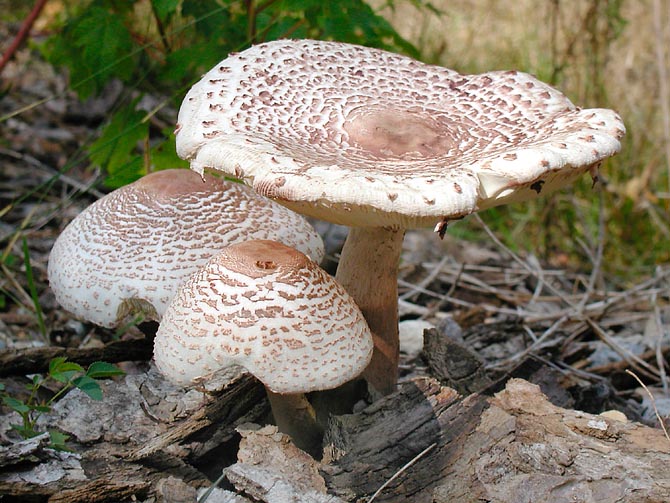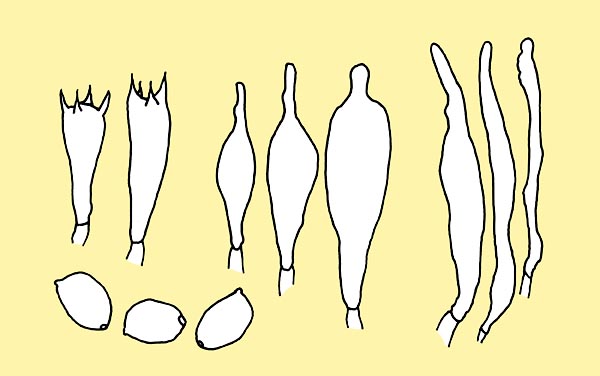
Text © Massimiliano Berretta

English translation by Mario Beltramini

Leucoagaricus americanus, slightly toxic if raw, is not edible © Giuseppe Mazza
Family: Agaricaceae Chevallier, 1826.
Genus: Leucoagaricus Locquin ex Singer, 1948.
Section: Annulati (Fries) Singer.
Subsection: Rubescente.
Leucoagaricus americanus (Peck) Vellinga, 2000.
The etymology of the name comes from the Latin americanus = American, of America.
It is a not interesting fungus from the edibility viewpoint, and for this reason the common names used for identifying it are rather scarce. In Italy, it is known, very generically, as “culumbina”; in France, “lépiote fascicule”; in the rest of Europe there are no other common names.
Description of the genus
To the genus Leucoagaricus are ascribed small, medium and at times even big species, heterogeneous with lepiotoid, tricholomatoid or collibioid deportment; the cap, whitish or coloured, at least partly, lively, the cuticle is smooth, fibrillose, scaly, powdery, dry and a little viscid; margin not striated; white or cream free gills with collarium; more or less cylindraceous stipe, at times enlarged at the base or bulbous, smooth, often hollow, fibrillose, scaly, normally with a membranous ring, mobile or not; flesh mostly meagre, whitish, cream, at times reddish or yellowish when cut. White or cream spores in mass. Terricolous, fimicolous, sabulicolous at times and on plants debris.
Description of the section and of the subsection
To the section Annulati belong species with fleshy cap, smooth, velvety squamulose, whitish, pale greyish, exceptionally brownish; amygdaliform spores with more or less evident germinative pore, metachromatic, sometimes weakly, with thick, smooth, wall; white, cream, orange cream or pink spore print, usually it darkens to cream with the dehydration; unchanging or turning yellow flesh, browning or reddening when rubbed; species mostly relatively fleshy, with silky surfaces which, in some species, tend to tear in flakes from fibrillose to scaly-fibrillose. The subsection Rubescente practically has the macro and micro characteristics of the species here described.
Description of the species
Cap: from 3 to 15 cm, initially oval, then convex up to flat, umbonate, white smooth and velvety cuticle, when breaking it gets covered by thick concentric scales starting from the margin, of cream colour up to brown-reddish to complete maturity, turns red when manipulated.
Hymenium: thick gills, free at the stem, with indented margin, high, white when young, cream-pink when ripe, stain of yellow and than of brown reddish when touched and compressed.

Leucoagaricus americanus basidia, cystidia, pileipellis and spores © Pierluigi Angeli
Stipe: up to 15 cm long x 1-2 cm of thickness, from fusiform to claviform, initially full then hollow, initially yellowing, then reddening when rubbed.
Ring: membranous, placed on the high past of the stipe, at times evanescent when ripe, white, can also become reddish in the ripe fungus.
Flesh: white, thick, when touched and cut turns yellowish then brown-reddish, mushroomy odour, pleasant taste.
Habitat: grows in small groups, mainly cespitous, from late summer to autumn, in humid zones rich of lignin, on the sawdust, on the litter of dried leaves, in parks and gardens; it does not disdain the dry climate, in such case, evidencing precociously the reddish hues.
Edibility: to be considered as not edible, slightly toxic when raw, it can cause gastric diseases to some people.
Reactions: cap orange-brown, then emerald green with Guaiacol; immediately emerald green with ammonia.
Microscopy: 8-11 × 6-7,5 μm, spores, smooth, elliptic, ovoid, with thick wall, with small and narrow germinative pore, pronounced apiculus, granulous, guttulous, dextrinoid, metachromatic. Basidia clavate, tetrasporic, some bisporic, without clamp connections, 29-38 × 7,5-9,5 µm. Cheilocystidia mostly clavate, but also lageniform with moniliform apex. Absence of Pleurocystidia. Pileipellis formed by irregularly intertwined hyphae with clavate or fusiform terminals.
Remarks: this is a species which, due to its size and its habitus, recalls a Macrolepiota, so much that Peck himself relates that it was described in an article as Agaricus rhacodes (nowadays Chlorophyllum rhacodes = Macrolepiota rhacodes); but the microscopic characters and especially the reaction to the green of the gills at the vapours of ammonia and the turning, when rubbed, initially safran yellow then reddish, place this species into the genus Leucoagaricus, section Annulati, subsection Rubescente. In Peck’s description it is described the collection habitat, grass verge, as well as the location, Buffalo. A certain similarity occurs with Luecoagaricus badhamii (Berkeley & Broome) Singer, which, however, at the least touch immediately turns bright red and then becomes brown in 1 or 2 minutes; also the microscopy is different, in this last one, in fact, are presente claviform and ventricose cystidia, with appendage and containing a red pigment. For distinguishing it from the near genera (Cystolepiota, Macrolepiota, Leucocoprinus) it is important to observe, besides the appearance, the morphology and the sporal metachromasia, the pileipellis and the shape of the basidia.
Synonims: Agaricus americanus Peck, (basionym), 1872; Agaricus bresadolae Schulzer, 1885; Chamaeceras bresadolae (Schulzer) Kuntze, 1898; Fungus bresadolae (Schulzer) Kuntze, 1898; Lepiota americana (Peck) Saccardo, 1887; Lepiota bresadolae Schulzer, 1885; Leucoagaricus bresadolae (Schulzer) Bon & Boiffard, 1977; Leucocoprinus americanus (Peck) Redhead, 1979; Leucocoprinus bresadolae (Schulzer) Wasser, 1978.
→ For general notions about Fungi please click here.
→ To appreciate the biodiversity of MUSHROOMS please click here.
